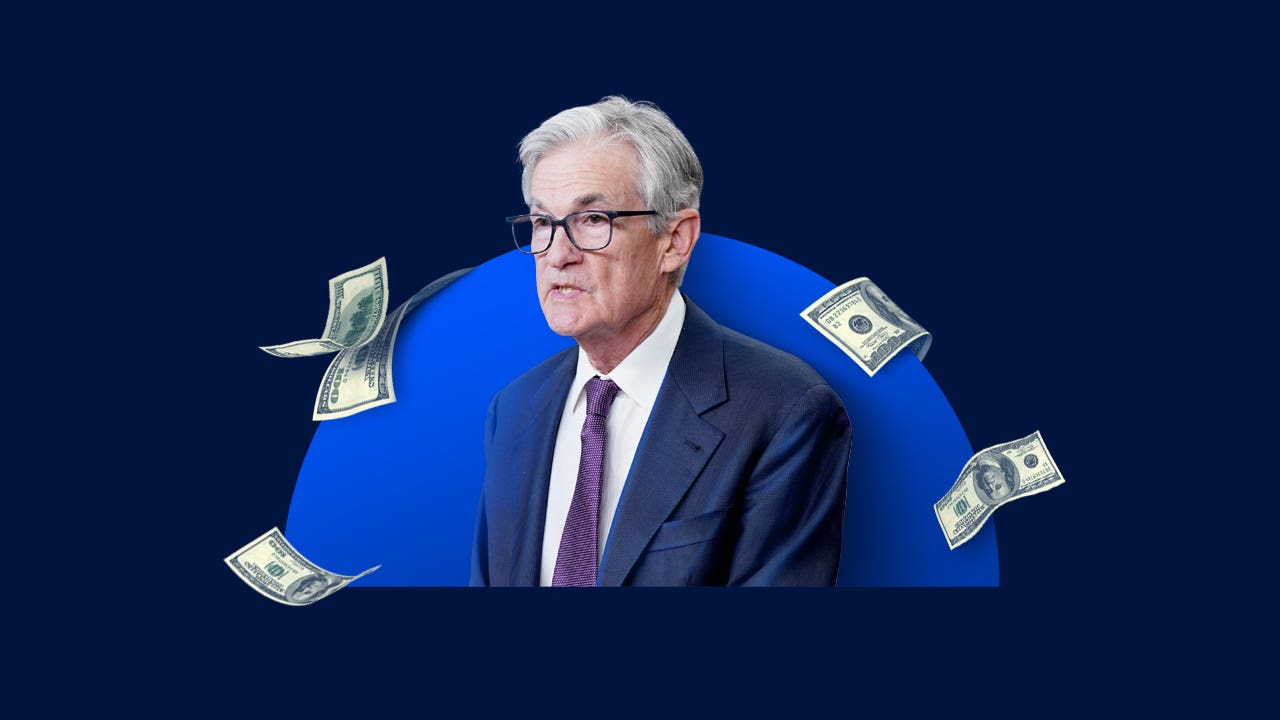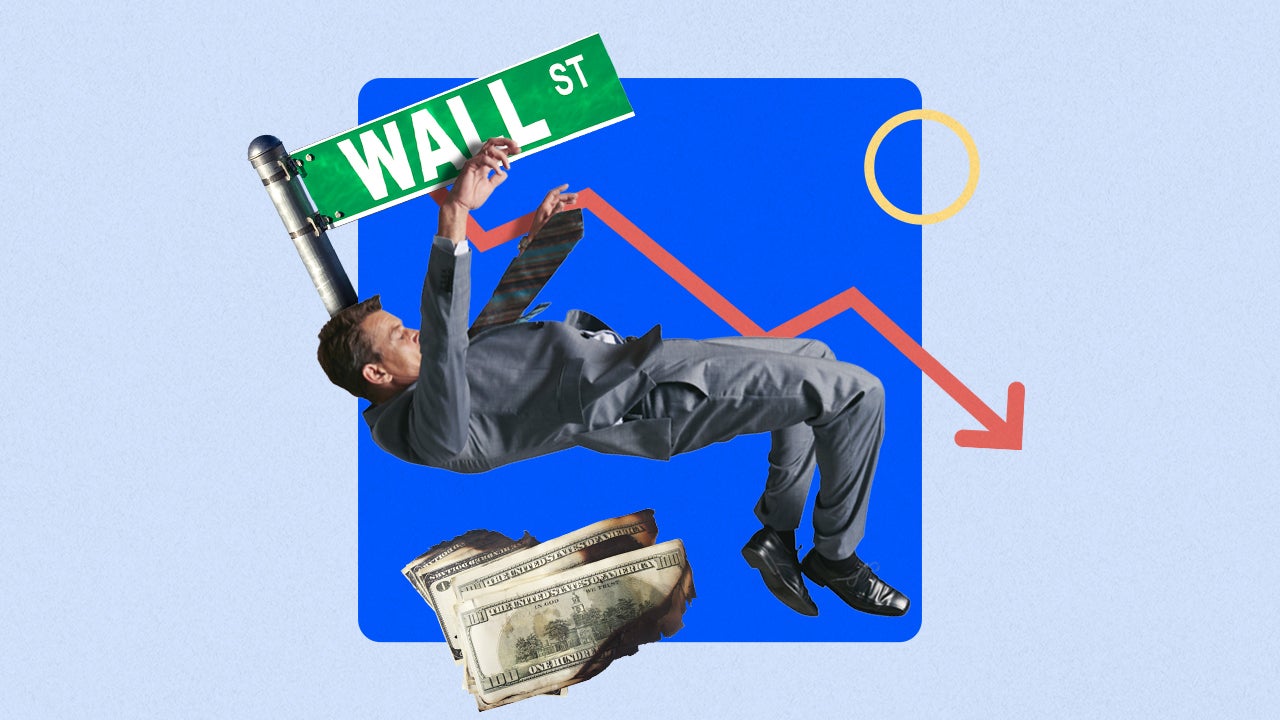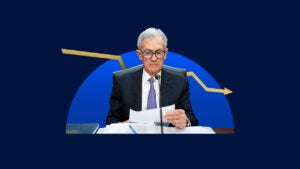Bankrate’s Q1 Economic Indicator Survey: Economists say there’s now a more than 1-in-3 chance of a U.S. recession in the next 12 months

Investors, consumers and economists were all just starting to grow hopeful that the Federal Reserve might be able to hammer away at inflation without causing severe economic damage. Then tariffs came along.
The odds of the U.S. economy entering a recession by March 2026 have risen to 36 percent, up from a series low of 26 percent in the fourth quarter of 2024, according to Bankrate’s latest Economic Indicator Poll. At the same time, the largest share of economists (55 percent) now say that inflation won’t return to the Fed’s target until the end of 2027, after the bulk of experts previously estimated that price pressures might finally slow in 2025 or 2026.
Policy uncertainties, including President Donald Trump’s threats to raise import taxes by the most in over a century, are behind those more downbeat estimates. The word “tariff” was mentioned 32 times in economists’ responses, while “policy” earned 19 mentions and “uncertain” or “uncertainty” garnered 15.
The Trump administration has imposed 25 percent levies on car and car parts, as well as steel and aluminum imports. He’s also preparing to slap a 10 percent baseline tariff on all U.S. imports, with higher levies on goods from key U.S. trading partners, such as China, Mexico, Canada and Japan.
The Trump administration hopes to reinvigorate U.S. manufacturing activity by deterring businesses from purchasing cheaper imports. Yet, economists say businesses could pass along those higher costs and also pull back on hiring, now that production costs are more expensive.
Individuals and households have been through a lot over the past several years, including the pandemic and related downturn, a burst of inflation and elevated prices, which persist. Risks of a recession are on the rise again, which boosts the chances of job loss and interruption in income.— Mark Hamrick, Bankrate senior economic analyst
Bankrate has been polling the nation’s top economists on their expectations for the job market, inflation, the Federal Reserve, economic growth and more on a quarterly basis for a decade. Read on for the latest findings.
Key takeaways from experts’ forecasts for the U.S. economy
Economists put the odds of a recession over the next 12 months at 36%, up from 26% in the fourth quarter of 2024 and the biggest jump since the third quarter of 2022.
More than half of economists (55%) expect that inflation will stay above the Federal Reserve’s 2% target through the end of 2027, up from just 15% in the prior-quarter poll. Previously, economists expected price pressures to cool in 2025 or 2026.
Economists now see job growth averaging just 92,000 positions over the next 12 months, the sharpest downgrade in two years after economists previously penciled in a 120,000 per month average pace.
Recession odds surge to 36%, the biggest jump since the third quarter of 2022
On its face, recession odds remain low. They’re nowhere near as high as they were back in the third quarter of 2022, when economists saw an almost 2-in-3 chance of a downturn (65 percent). Meanwhile, the current odds have only slightly increased from where they were at this time a year ago (33 percent in Q1 2024 versus the current level of 36 percent).
Yet, it’s how much those odds have increased that’s catching the attention of some economists — and even consumers. In the prior-quarter poll, economists pegged the chances of a downturn at 26 percent. Now, they’ve shot up to 36 percent — the biggest surge since the third quarter of 2022, when the odds of a downturn jumped from 52 percent to 65 percent.
Almost every economist noted that trade policy and policy uncertainties could be what ultimately tips the scales toward a recession. Unsure of what to expect from the Trump administration’s tariff plans, businesses might hold off on hiring, investments and expansions. Hit with higher taxes on the goods that they import, firms might also face supply chain snarls that make it harder to produce the same amount of goods and services. Not to mention, consumers still reeling from post-pandemic inflation might ultimately have no choice but to cut spending — robbing the U.S. economy of its main engine for growth.
“The rapidly shifting policy landscape is causing angst amongst businesses and consumers,” said Dante DeAntonio, senior director of economic research at Moody’s Analytics. “While this is not yet enough to tip the economy into recession, the threat of a further escalation in the trade war or other policy-related uncertainty could push the economy in that direction.”
Some measures already suggest that Americans are beginning to pull back. Spending grew less than expected in February, while Americans’ savings rates edged up, according to the latest data from the Department of Commerce.
For now, labor market data still continues to paint a positive picture, economists noted. But those figures are backward-looking, and the U.S. economy — having already slowed in response to the Fed’s rapid rate hikes — might not be in a position to handle more external shocks, many also noted.
“Recent survey data have cast a negative light on the economy, but it’s important to remember that the hard data, which matter more, still carry a positive tone,” says Oren Klachkin, financial market economist at Nationwide. “For now, we think the glass is half full.”
What the nation’s top economists are saying about recession risks
Recession risks have risen considerably in recent months as consumers and businesses curtail their spending due to policy and as policy impacts uncertainties. Currently, the biggest risk to financial markets and economic activity stems from the decline in consumer and corporate sentiment and loss of confidence in the economy.— Selma Hepp, chief economist at Cotality
We don't see an elevated risk of a recession in the next 12 months. The U.S. remains strong with underlying economic factors all pointing to resilience. However, we have increased our recession probability because of the threats of elevated tariffs that could be a major drag on GDP.— Tuan Nguyen, Economist at RSM
While we are not in a recession today, the forces weighing on growth are intensifying, and the risk of a self-fulfilling downturn is real. The interplay between policy decisions, financial markets and consumer and business sentiment will be critical in determining whether this slowdown remains contained or spirals into something deeper.— Gregory Daco, Chief Economist at EY
Consumers are still angry about inflation that happened in 2022 and renewed inflation now will likely damage confidence, keep the Fed from lowering rates as they normally would and cause businesses to cut back on investment. And that doesn't include the loss of exports due to other nations imposing tariffs and import controls on U.S. goods.— Joel L. Naroff, President at Naroff Economics
Economists now expect inflation to stay hot through the end of 2027
Three months ago, economists were already casting doubt on the Federal Reserve’s ability to declare victory over inflation by this year’s end. Only 30 percent expected price pressures to reach the Fed’s 2 percent target by the end of 2025 in Bankrate’s previous quarterly poll, a sharp decline from 71 percent in Q3 2024. The largest share (35 percent) believed that elevated inflation could persist until the end of 2026.
But now, tariffs are making that picture even worse.
According to the latest survey data, the majority of economists (55 percent) now anticipate that price pressures will not align with the Fed’s target until the end of 2027. None of the economists surveyed continue to expect that inflation will reach 2 percent by the end of this year.
Another 25 percent remain optimistic about inflation returning to 2 percent by the end of 2026, according to Bankrate’s survey. About 1 in 5 (or 20 percent) selected “other/don’t know.”
Economists’ projections are now in line with the U.S. central bank’s outlook, after previously being more optimistic than the Fed itself. Since December, Fed officials have estimated that inflation wouldn’t return to its 2 percent goalpost until 2027. They retained that outlook again in March, according to their latest economic projections.
Estimates on how much tariffs might impact inflation vary, with the most pessimistic projections suggesting prices could rise an additional 2.1 percent, according to the Yale Budget Lab. As of February, inflation rose by 2.8 percent, according to the Bureau of Labor Statistics’ consumer price index (CPI). Excluding food and energy, prices surged by a more significant 3.1 percent.
Some prices that had previously been falling — such as electronics or other goods and commodities — started increasing again last month.
“Inflation has started to move up now, we think partly in response to tariffs,” said Fed Chair Jerome Powell in March. “There may be a delay in further progress over the course of this year.”
What the nation’s top economists are saying about inflation
The ongoing implementation of tariffs and the resulting trade war will cause inflation to modestly re-accelerate through the end of 2025. Economic growth will also come in slightly below potential, as shifting economic policy causes increased uncertainty among businesses and consumers. These two factors will pull the Federal Reserve in opposite directions.— Dante DeAntonio, Senior Director of Economic Research at Moody's Analytics
Tariff increases, if they remain in place over the coming year, will delay the return of inflation to the Fed's target for at least the next two years.— Scott Anderson, chief U.S. economist at BMO Capital Markets
New uncertainty has emerged in the path to slower inflation due to proposed policies and their potential impacts. However, some factors will likely continue to exert downward pressure on inflation, including the ongoing deceleration of shelter inflation, a cooling labor market and an increase in productivity growth.— Mark Fleming, Chief Economist at First American Financial Corporation
A growing economy will keep inflation from falling quickly to 2%. Services inflation remains stubborn and goods prices may receive a jolt from tariffs. The aggregate policy mix tilts inflation risks to the upside, in our view.— Oren Klachkin, Financial Market Economist at Nationwide
Economists downgrade their job growth forecasts by the most in two years
The job market has remained the one bright spot in the U.S. economy — but trade policy uncertainties could soon even jeopardize hiring, the nation’s top economists noted.
Employers are still expected to create new positions in the year ahead, with economists projecting that job growth will average 92,000 a month over the next 12 months, Bankrate’s survey found. Yet, those are the weakest forecasts since the fourth quarter of 2023. Compared with the prior-quarter’s expected pace of 120,000, those updated projections also now mark the sharpest downgrade in two years.
Responses ranged from a high of 170,000, suggesting that one economist expects job growth to accelerate in the year ahead. The most pessimistic forecast, however, projects that employers will eliminate more positions than they create, with job cuts averaging 16,000 positions a month as uncertainty weighs on spending and hiring.
Meanwhile, economists expect unemployment to rise, hitting 4.5 percent in March 2025 from its current 4.1 percent level. That would be the highest rate of the post-pandemic era, eclipsing the high of 4.3 percent from July 2024.
Unemployment forecasts ranged from as high as 4.8 percent to as low as 4.1 percent, according to the latest poll. Notably, no economist expects unemployment to edge lower over the course of the year. Previously, 20 percent expected that the nation’s joblessness rate would fall further this year.
“Business executives continue to rein in hiring but are still holding off on broad-based layoffs as they navigate a more uncertain economic and policy environment,” says Gregory Daco, chief economist at EY.
What the nation’s top economists are saying about the job market
If heightened uncertainty continues to weigh on business investment decisions, the next shoe to drop will be hiring decisions or the use of layoffs to preserve margins.— Yelena Maleyev, senior economist at KPMG
The labor market is going to soften further because the lingering impact of the surge in policy uncertainty is suffocating, which weighs on private hiring, business investment in equipment and nonresidential structures.— Ryan Sweet, chief economist at Oxford Economics
Momentum in job creation is slowing as businesses remain cautious. However, overall conditions are still positive with a lingering need for workers.— Lindsey Piegza, Ph.D., chief economist and managing director at Stifel, Nicolaus & Co.
The job market will slow with the pace of growth and fewer immigrants entering the labor force. The risks are to the downside.— Peter Morici, professor emeritus at the University of Maryland
Layoffs and dismissals remain low, with many businesses exercising caution in the context of limited labor availability. Instead of making cuts to their labor force and risk being caught short when demand picks up, these firms are instead reducing hiring and allowing attrition to lower their workforce numbers.— Lauren Saidel-Baker, economist at ITR Economics
Economists weigh in: Is the U.S. economy heading toward ‘stagflation’?
Anytime economists start to expect higher inflation, weaker economic growth and a cooler labor market, one word with a nasty reputation starts to creep into their discussions: Stagflation.
Simply put, stagflation is an economic environment featuring those three economic ingredients. Americans who lived through the inflation crisis — and the devastating recession that followed — in the 1970s and ‘80s were the last to experience it.
It’s a challenging loop to break, in part because weaker economic growth and higher inflation require two different policy responses. When the U.S. economy slows, the Fed often cuts interest rates. When prices rise, U.S. central bankers might decide to raise interest rates.
Whether the U.S. economy will experience another painful bout of stagflation might come down to technical definitions, according to economists in Bankrate’s survey.
“Some define stagflation as weaker growth and accelerating inflation,” says Ryan Sweet, chief economist at Oxford Economics. “We believe this definition is too loose and the stagflation period of the 1970s and 1980s is a severe example.”
In order to fulfill his definition of stagflation, inflation would need to be a full percentage point above the Fed’s 2 percent target, Sweet says. The unemployment rate, meanwhile, would need to be a percentage point above 4.3%, his team’s estimate of full employment, he adds. Sweet isn’t expecting inflation nor unemployment to rise to those levels. Yet, he also admits that “a good economist would never say there is zero probability of any scenario. Therefore, we aren’t discounting the risk of stagflation,” he says.
Even if economists were divided on whether the U.S. economy could experience “true” stagflation, many admitted that the U.S. economy might feel similar to it.
What the nation’s top economists are saying about the risks of stagflation
I don't expect a stagflation scenario — just weaker growth and higher inflation.— John E. Silvia, Founder of Dynamic Economic Strategy
It's unlikely that either the inflation rate or the jobless rate will become historically high in 2025, so we won't face outright ‘stagflation,’ but the risk is that the economy moves in the direction of stagflation with tariffs, which will have the effect of raising both the inflation and jobless rates.— Mike Englund, Chief Economist, Action Economics
We do see slower growth and higher inflation in 2025, but stagflation in the sense of sustained very low growth, well above target inflation and a sharp rise in unemployment still seems unlikely.— Brian Coulton, Chief Economist at Fitch Ratings
The outlook has moved in a stagflationary direction, both slower growth and higher inflation relative to our prior forecast. There is a risk that the U.S. economy could both enter a recession and still have inflation above the Fed's 2% target.— Mike Fratantoni, Chief Economist at the Mortgage Bankers Association
Worried about the state of the U.S. economy? Here’s what you should do with your finances
Economists and investors have long been obsessed with predicting the cause of the next recession. Many warned that one was inevitable when the Fed first started raising interest rates to cool inflation in 2022. They’re now worried a downturn is around the corner as the Trump administration upends decades’ worth of open trade agreements with his protectionist tariff policies.
But for most Americans, there’s no use in tracking the latest bogeyman of the day because it doesn’t change any of the steps you should take with your finances.
Worried about the current economic outlook? Here are the most important steps to take with your wallet:
- Recession-proof your finances: Fundamental to your recession-preparedness is building up an emergency fund. Prioritize saving any little bit that you can. If you have high-interest debt, particularly from a credit card, you might be able to free up even more cash that you can put toward your savings by eliminating your balance. Consider utilizing a balance-transfer card that can offer you a 0 percent introductory annual percentage rate (APR) for a fixed number of months.
- Don’t succumb to panic-buying: Americans might be tempted to buy items in bulk or make a big-ticket purchase now, out of fear that prices on them might eventually go up. Unless you’ve already budgeted for those purchases, though, those steps might be unwise, financial experts say. Spending more money might not help you in your goals to save more.
- Stay the course with your investments: Financial markets have been choppy lately, as investors process a never-ending onslaught of back-and-forth tariff announcements. You might be tempted to check your 401(k) balance, pull out of the market or take a more conservative investing approach. Yet, if you have years left before you need those funds, selling now while markets are in the red might be a decision that ends up hurting you down the line, experts say.
You may also like

Survey: Economists see 59% chance of a recession by July 2024





